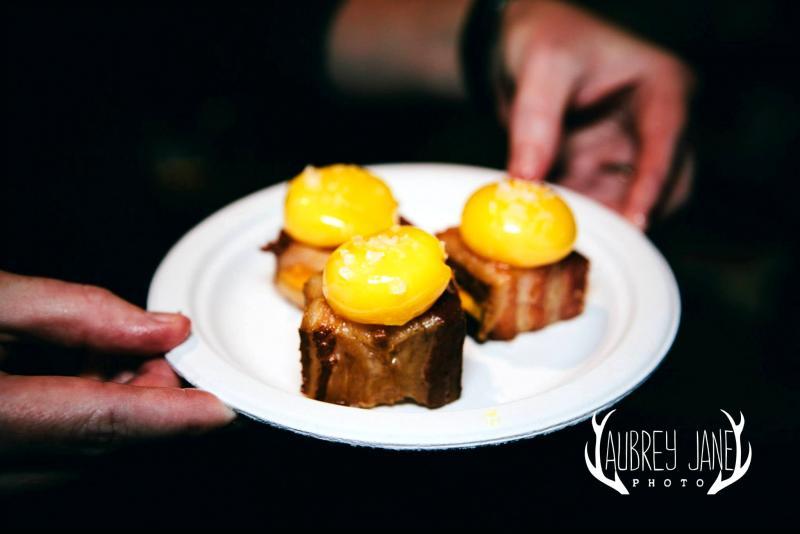-
Posts
1,807 -
Joined
-
Last visited
Content Type
Profiles
Forums
Store
Help Articles
Everything posted by btbyrd
-
Help me use this: Winter is prime stock making season in my house. A foot of snow on the ground totally eliminates the need for an ice water bath to cool finished stock down to storage temperatures so I go crazy and make more than I can use. I've started to compulsively buy up prime stock-making ingredients at the grocery when they go on sale... whenever there are markdowns on short ribs, oxtail, spare ribs, pork neck bones, chicken wings, etc.I buy a bundle of them, roast them off, and move them to the pressure cooker. Then I stick it outside until it's ice cold, skim off the fat (which I also save) and then seal it up in my chamber vacuum. As a result, my freezer is full of vacuum sealed bags of nice gelatinous stock. This is awesome. But I'm not quite sure what to do with all of it. First world problems. I usually use it for three, somewhat obvious purposes. The first is to make soup, which I can produce without even blinking. Meat/bone broths are something I've mastered over the past few years, with my wife remarking that I can make a chicken soup that would make grandmothers weep. My pho and ramen game is as good as any of my local shops. And my French onion soup? To die for. I love a good soup when it's cold out, but I can't make enough to use my supply. The second purpose to which I put my stock supply is the making of sauces. Reduce a stock down, infuse some herbs, add some acid and some fat (and maybe some starch) and spoon it over a quality piece of meat. What's not to like? Finally, I use stock as the foundation for braising liquid when cooking tough cuts, stews, or pot roasts. Those are the main purposes for which I use stock. There are other side uses... glazing vegetables, cooking rice or risotto, etc. But what else should I be doing with it? Or should I just eat more soup?
-
If you want to get nerdy, check out "The Effect of Milk on the Deodorization of Malodorous Breath After Garlic Consumption" by Areerat Hansanugrum. Section 4.1.1.1. (starting on p.48) is most relevant. The results were basically what I expected. Some of the volatile compounds responsible for harsh garlic flavor/aroma are hydrophobic so water isn't great at removing them. Water is effective in removing other volatiles, however. But the best way to remove these compounds is by using a liquid (like milk) that contains a mixture of fat and water. An interesting result that I didn't expect was that blanched and unblanched garlic showed the same basic behavior. This suggests that chefs blanch garlic not only to remove unwanted volatiles, but also to modify garlic's texture.
-
I meant I don't "just" thaw with the circulator. If I'm going to cook frozen food sous vide, I drop it directly in the bath from frozen. But if I just need to thaw something, I use a smaller amount of water in the sink.
-
I cook SV from frozen all the time but I don't thaw in the circulator; a container of water in the sink works well enough for my purposes. It takes less water and I don't have to wait for a water bath to come up to temperature. Rapid thawing of meat in warm water does not compromise texture or appearance and actually reduces drip loss, resulting in meat that may be perceived as juicier. Chicken breasts lose slightly more juice when rapidly thawed, but the texture doesn't suffer and tasters could not tell the difference between rapid/slow thawed chicken after it was cooked.
-
There's a large range of qualities that one can refer to when discussing mouth feel. Gawel et. al developed a vocabulary for communicating the mouthfeel characteristics of red wine. Chewiness, for example. is said to "give the sensation that mouth movements (chewing) can displace the sensation of astringency." When talking about fats in particular, there are a number of associated textural/mouthfeel characteristics associated with lipids. These include "body, creamy, gelatinous, greasy, melting, oily, slimy, smooth, sticky, thick, thin, waxy, and wet." If you really want to nerd out about the topic, Frontiers in Neuroscience published the anthology "Fat Detection: Taste, Texture, and Post Ingestive Effects" which you can read for free. There are chapters on gustatory and olfactory detection of fat along with a good piece by Mattes on whether fat counts as a primary taste.
-
Another great way to create a flavorful mushroom broth is to pulse fresh mushrooms in the food processor until they're finely chopped, vacuum seal them with a small amount of salt, and cook them sous vide at 90C for two hours or so. This produces an intense "mushroom water" that you can use however you'd like.
-
More Than Gourmet makes a concentrated mushroom stock. I'd much rather use that than anything else that's been mentioned.
-
I can't find the nutrition information, but I'd bet that it's high in sodium. The ingredients are: "Flavor enhancer (monosodium glutamate, disodium 5' ribonucleotide), salt, rice, sugar, acid hydrolyzed vegetable protein seasoning (contains soya), flavoring, dehydrated mushroom." No wonder it's "like mushroom MSG." It is mushroom MSG.
-
Just dropping by the thread to express my undying hatred for "The Kitchen" on Food Network.
-
I was reading up on biscuits when I saw this comment by Chris Young about why ChefSteps' biscuit recipe calls for both salt and salted butter. "Salted butter has a different flavor profile due to the fact that salt promotes the oxidation of the butterfat, which leads to the development of different flavors than you get in unsalted butter. "
-
Wow! Insane skills.
-
Porthos: Fantastic job cleaning up those pans... they look brand new when you're done! I searched (to no avail) to find your technique for getting the big glunky rocks of black stuff off the exterior of the pan. What's your process there?
-
I'm with Baron. Burned flavor is bitter and tastes bad. Contrary to FeChef's question, a few minutes is more than enough time to caramelize a piece of meat (or produce Maillard flavors). If a cooking method is sufficient to burn part of a piece of meat, it's sufficient to produce caramelized/Maillard flavors in those parts. Browning reactions happen at a lower temperatures than burning/blackening does. Much of the grilled flavor imparted to meat comes from juice and fat dripping down onto the coals (or other heating element) and then vaporizing and combusting. These flare ups create a meat-based vapor / smoke which wafts up and flavors the meat. You can produce a steak that has great grilled flavor but has very little (if any) blackening. Here's a nice video from ChefSteps on flareups and grilled flavor.
-
Different butters contain different salt levels, so it makes sense if you're trying to create a consistent result. Who measures salt by volume anyway? The difference between table salt and various types of kosher salt can vary by more then 100%. The difference between 1.5 tsp salt and 1/8 tsp is far from insignificant. You'd have to use 12 times as much salted butter to match the salt level. I call foolishness on those who ignore such a giant difference. I agree that the recipe should specify the sodium content of the broth, but people should be using (unsalted) stock for cooking anyway.
-
Nope. I bought lard and cold smoked it, and then used that to fry like 5 pounds of smoked pork belly. It's basically bacon fat without the salt. Since this is the SV thread, here's a pic of the pork belly dish, "Bacon, egg, and cheese." Brined, cold smoked belly cooked 48hrs @ 62C. Chilled, pressed, portioned. Stuffed with Kerrygold cheddar. Topped with 64.3C yolk and Maldon salt.
-
Last night's dinner: 48 hour short ribs, chive butter, ChefSteps triple cooked chips. Fried everything in smoked lard. Served with a hyperdecanted cabernet sauvignon.
-
For beef, pork, or chicken, I often cook from frozen. For fish, which is more delicate and whose texture can really suffer from enzymatic breakdown, I thaw before cooking. I usually throw it in the fridge a day or two before I think I'm going to cook it. If I'm in a time crunch, I'll thaw it in cold water.
-
I used to obsess about this kind of thing but I don't anymore. Most commercial cryovac bags are polyethylene, so there's not much of an issue. Even if they were one of the nastier BPA containing plastics, the temperature and time on something like fish (or a medium rare steak) isn't high enough to concern me. I assume that if it looks like a SV safe vacuum bag, it probably is a SV save vacuum bag. YMMV.
-
On a related note, the first ingredient in Shel's preferred brand of cream of mushroom soup is water. This is followed by mushrooms, mushroom flavor base, and mushroom concentrate.
-
That would be "BeefaRoni." Rice-a-Roni's jingle was: "Rice! a-Roni... The San Francisco treat!"
-
I did some math and figured you're overpaying for short ribs. But +1 on your technique suggestions. I find that flank or skirt steak are great mixed with short rib for a burger blend. Kenji over at Serious Eats likes oxtail too, but that can be sort of a pain to cut and clean before grinding.
-
That would work. It is common in Asian cuisines to use the steeping liquid from rehydrating dried mushrooms to make stock. It's quite flavorful.
-
Use more bones.
-
Ah. My understanding was that he was cooking in bags inside a water bath inside an oven set to a low temperature.





